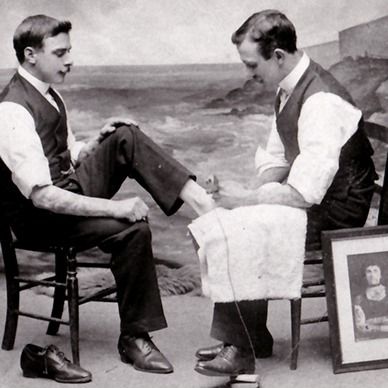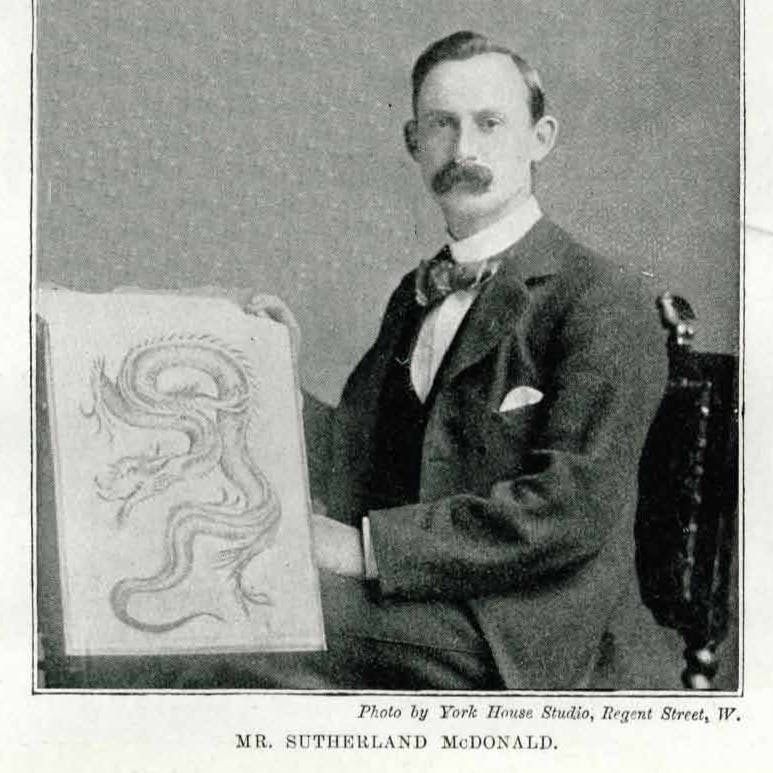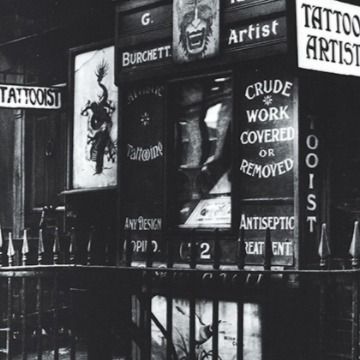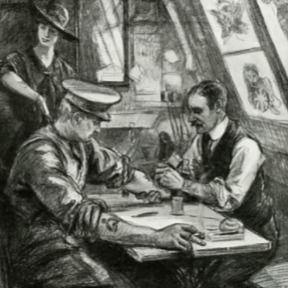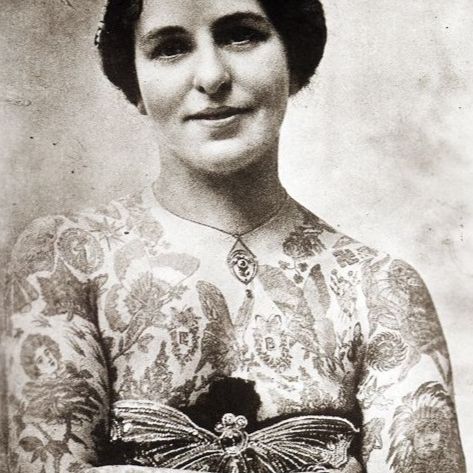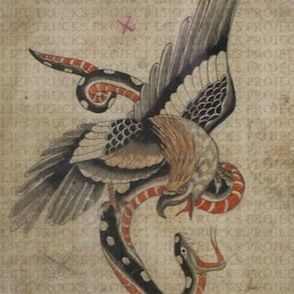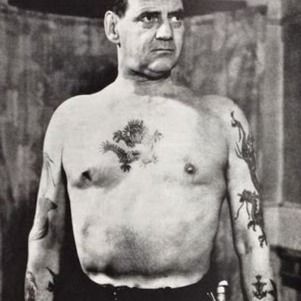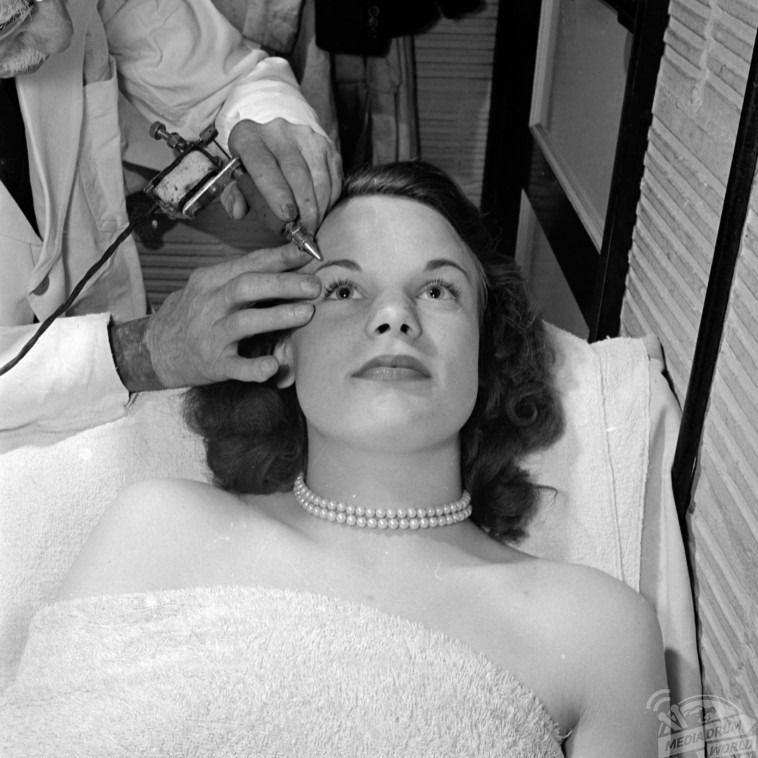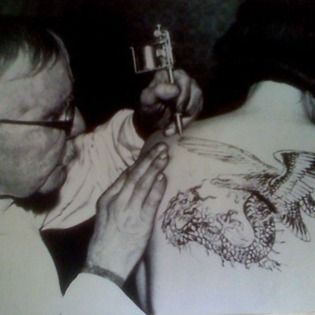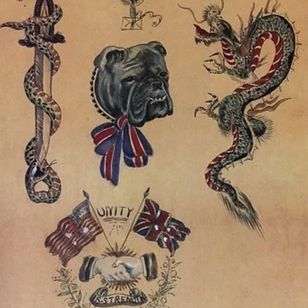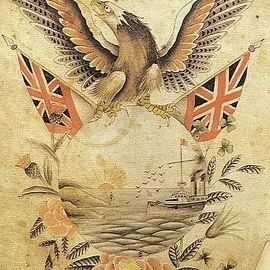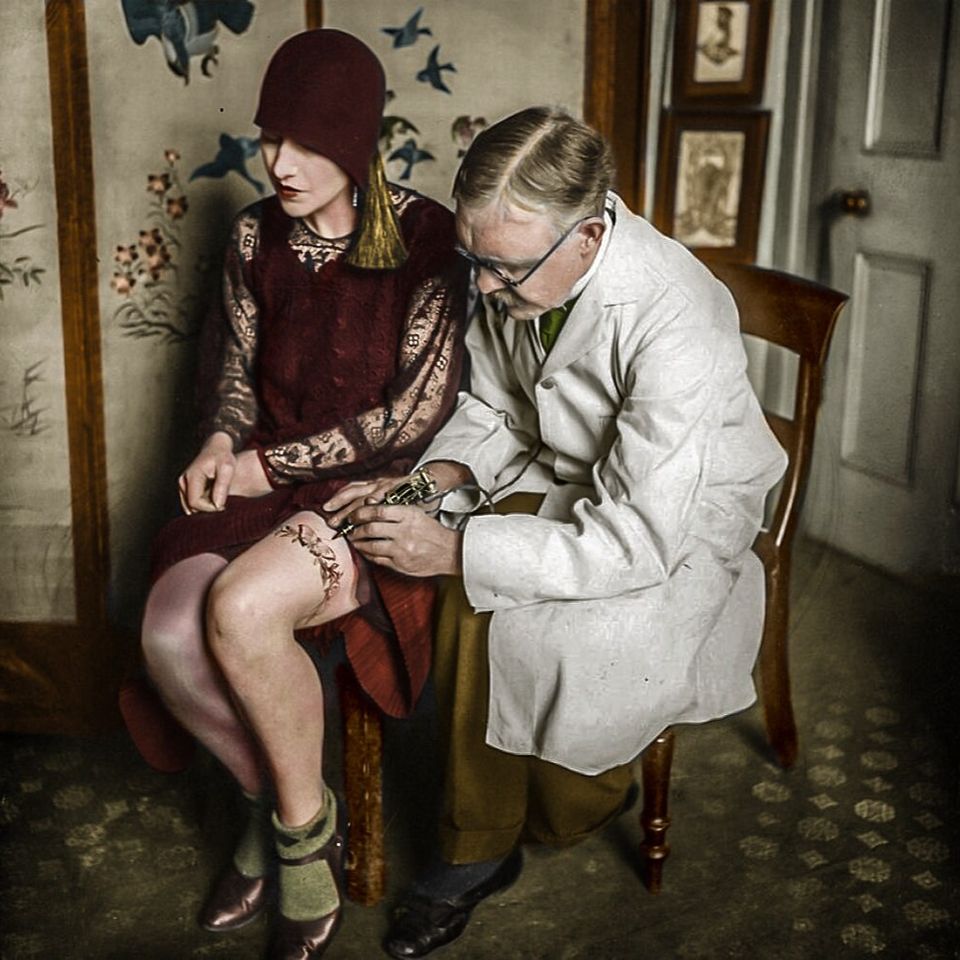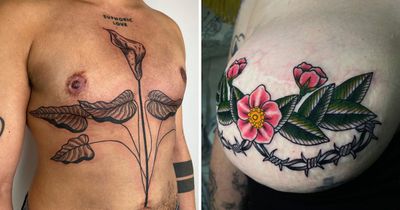King of Tattooists: The Life of George Burchett
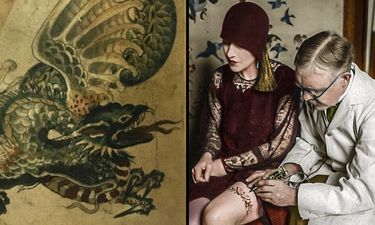
Delve into the captivating life story of George Burchett, affectionately known as the King of Tattooists.
George “Professor” Burchett was arguably the most famous tattoo artist in the UK and Europe throughout the first half of the twentieth century. Over his mighty fifty year career, the King of Tattooists served everyone from servicemen to royalty and even invented his own form of tattooing. In this article, we uncover the history of George’s life and work, from his naval years to the height of his tattooing career.
Early Life
Born on the 23rd of August 1872 in Brighton, George was the eldest of George and Lydia Burchett-Davis’ eleven children. He became interested in tattooing at an early age, after seeing inked performers and tattooists during a visit to the Royal Aquarium in London.
As a child, his younger brother would let him scratch designs into his skin in return for sweets. George would also practise on his fellow classmates, which led to him being expelled from school at just twelve years old.
After leaving school, George Burchett-Davis apprenticed at Muttons Hotel, Brighton and later worked as a boot repairer in Hackney. Then in 1889, against his parent’s wishes, he enlisted in the Royal Navy with his grandmother’s consent.
Naval Career
On his first international tour, he worked as a Deckhand aboard the HMS Vincent. Alongside his crewmates, he visited the West Indies, Africa, India, the Mediterranean and the Far East, and was greatly inspired by the native tattoos that he witnessed.
During this voyage, George acquired his first tattooing kit from an able seaman named Weatherby and began to develop his skill by inking his fellow sailors. George also got several tattoos of his own whilst overseas, including a design by legendary Japanese tattoo artist Hori Choyo while in Yokohama.
Ultimately, the structure of military life didn’t suit George and his naval career was short-lived. Whilst on shore leave in Jaffa, Israel, he deserted his ship and briefly set up shop in Jerusalem. For a short time, he made a living tattooing Western travellers there, before boarding a Spanish merchant ship to evade the authorities and avoid punishment.
After lying low for twelve years, George decided it was time to return to England. In 1896, he dropped “Davis” from his surname and started a new life in London as George Burchett.
Early Tattooing Career
Upon his return, George initially set up shop as a cobbler on Mile End Road. When he wasn’t repairing shoes or doing odd jobs like selling tram tickets to raise extra cash, he would tattoo people in the back room of his shop.
In 1898, he married Edith Smith Walters and the couple set up home in Bow, East London. Around this time, he also met legendary tattoo artists Tom Riley and Sutherland Macdonald. Having seen potential in George, Macdonald decided to take him under his wing and train him in the use of his newly invented electric tattooing machine.
Thanks to this stroke of luck, George Burchett’s reputation as a talented artist grew and he gained many working class patrons. He became particularly popular amongst sailors and dock workers, and was able to give up cobbling work entirely by 1900.
Waterloo Road Studio
Four years later, George and his family had moved from Mile End Road to premises on Waterloo Road in the city centre, near Waterloo Station. This prominent position served them well, particularly during the First World War, as soldiers would stop by to get a design before heading to the front line.
In 1917, George told The Graphic newspaper: “It’s a busy life now – one long rush; but the customers chiefly wear khaki or blue – except a few ladies who come to have “his” regimental badge put on their arms for keeps.”
In the same article, the reporter described George as an artist whose electric tattoo machine was ‘like a brass pencil, needle tipped’, which enabled him to work swiftly.
His Waterloo Road studio was said to be simply furnished with weird pictures, a big table, a few chairs and a shelf full of colours in small boxes. Small white china palettes held the ink colours to be used during the process and finished designs were sealed with Vaseline.
Tattooing Style
During the same year, George Burchett was depicted inking both men and women, tattooing all kinds of designs from military insignias to portraits of the king, bulldogs to pin-up girls.
He also did numerous flash designs, including tigers, snakes, oriental dragons, rose garlands with the word “Mother” and iconic heart and banner motifs. But his skills didn’t end there. George also tattooed intricate portraits and delicate nature designs, famously modelled by his wife Edith.
His diverse artwork was heavily influenced by his travels and as such contained African, Japanese and Asian elements. Despite this, George’s art had a quintessentially English feel that was more fluid and visually appealing than the heavy American line-work of the era.
With a permanent shop and a steady stream of satisfied clients, George’s talents began to gain attention from the elite members of society. While many wealthy clients had previously visited Japanese fine artists for their ink, they were now going to George Burchett, whose tattooing machine and topical anaesthetic made the designs less painful and more detailed.
After thirty years in the business, George Burchett had amassed an impressive list of clients, including royalty. He famously tattooed the dragon on King Frederick IX of Denmark’s chest, and he also tattooed designs on King George V and King Alfonso XIII of Spain.
The Great Omi
Aside from royals, George’s most famous client was Horace Ridler, aka The Great Omi. Born in 1886, Ridler grew up in an upper-class family near London. He served as an officer in the Army and led a relatively normal life until the1920s.
After the First World War ended, fewer job prospects meant that Ridler had to find a new way to make a living. With the several tattoos he already had, he began exhibiting himself as a sideshow entertainer in 1922. However, competition was rife and he soon realised that his existing body art wouldn’t be enough to ensure a steady income.
Some time around 1927, Ridler wrote to George Burchett and requested that he transform him into the greatest tattoo attraction in the world. More specifically, he wanted to be covered head to toe in thick black stripes, to create the appearance of a human zebra.
After gaining written consent from both Ridler and his wife, Burchett began work on the huge project which cost thousands of pounds and took 150 hours to complete. George later said: “To become a freak in order to earn a livelihood was a gamble which might not have come off. Fortunately it did.”
Later Years
In the 1930s, he extended his service offering to include his self-invented cosmetic tattooing. Women travelled from all over Europe to have their complexions lightened, cheeks and lips tinted and permanent eyebrows and beauty spots added, to enhance their beauty.
As a talented artist with numerous high-society clients, George Burchett became the most famous British tattooist of the early twentieth century. He appeared in newspapers, on cigarette cards and later on television.
In 1942, at the age of 70, he attempted to retire and hand the business over to his sons. However, an increased demand for tattoos during the Second World War saw him return to work to help them deal with the influx of new clients.
During an interview in 1940 George said: “I’ve been working for 36 years in Waterloo Road and I’ve never been busier than today. These young fellows in the army will have their girls’ names and hearts and love knots tattooed on them just as their fathers and grandfathers did… I have never found patriotic emblems so greatly in demand as now.”
After the war, George continued tattooing and never did retire from the career he loved so much. He tattooed until the age of 80, when he passed away suddenly on Good Friday in 1953, at his home in Surrey.
Legacy
George Burchett’s tattooing career spanned more than five decades. During that time, he built up a remarkable portfolio, inking people from all different backgrounds and never forgetting his military roots. From soldiers to nobles, George welcomed everyone into his studio, having transformed his back-street gig into a prosperous business in central London.
An industry pioneer, he helped to change attitudes by positioning tattooing as a professional art form. This feat, alongside his exceptional talent, makes it clear why George Burchett was coined the King of Tattooists and why he remains deserving of his title to this today.
Sources:
Margo DeMello, Encyclopedia of Body Adornment, 2007.
“New Military Tattoo is Popular”, Leicester Evening Mail, 18th May 1940.
Matt Lodder, George Burchett: The Man, The Myth, The Legend, 2013.
Matt Lodder, Oxford Dictionary of National Biography: Burchett, George (1872–1953), 2016.
“Warriors Decorated at Waterloo Road”, The Graphic, 21st July 1917.


